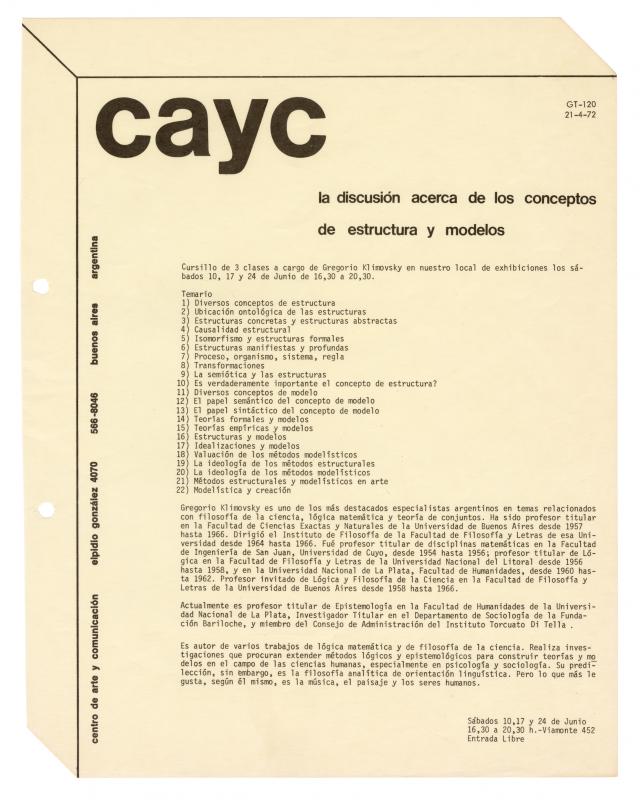Ever since it was founded, the CAYC (Centro de Arte y Comunicación), helmed by the cultural promoter, artist, and businessman Jorge Glusberg, was intended as an interdisciplinary space where an experimental art movement could flourish. The establishment of collaborative networks connecting local and international artists and critics played an important role in this process. In addition to the exhibitions, a program of different activities exposed attendees to the latest in scientific thinking. According to Glusberg, the coordination between theoretical thinking and artistic practice was an essential part of social change.
During the military dictatorship of General Juan Carlos Onganía, the CAYC became a cultural home for the Fundación de Investigación Interdisciplinaria, a space that welcomed a group of dissident professors from the Facultad de Arquitectura y Ciencias Exactas de la Universidad de Buenos Aires after the military takeover of the university in what came to be known as “La Noche de los Bastones Largos” in June 1966. In its early years the center organized a variety of activities with intellectuals that contributed to the circulation of ideas from different disciplines (analytical philosophy, mathematical logic, epistemological problems, psychology, semiotics, and linguistics), which had been excluded from official circles after the military coup d’état.
The Sociedad Argentina de Análisis Filosófico (SADAFwas one of the civil associations that welcomed university professors who had resigned their positions after the military takeover of universities. Following the model of the American Philosophical Society, the SADAF set out to organize groups and events devoted to the discussion and exposure of philosophical analysis. Its original list of members included Eugenio Bulygin, Genaro Carrió, Alberto Coffa, Juan Carlos D’Alessio, Rolando García, Ricardo Gómez, Gregorio Klimovsky, Raúl Orayen, Eduardo Rabossi, Félix Schuster, and Thomas Moro Simpson.
Eduardo Rabossi (1930–2005) was a philosopher, writer, lawyer, and politician. In 1966, after the universities were taken over by the military, he resigned from the Universidad de Buenos Aires (UBA) where he held a teaching position. He then went to Oxford University, initially on a grant from the British Council and then on a scholarship from the John Simon Guggenheim Memorial Foundation. When he returned to Buenos Aires in 1970 he and some of his university colleagues founded the Sociedad Argentina de Análisis Filosófico (SADAF). (See the following documents in the ICAA Digital Archive: GT 120 [la lógica y el método hipotético deductivo]; doc. no. 1478803, GT 120 [la discusión acerca de los conceptos de estructura y modelos]; doc. no. 1478802.)

